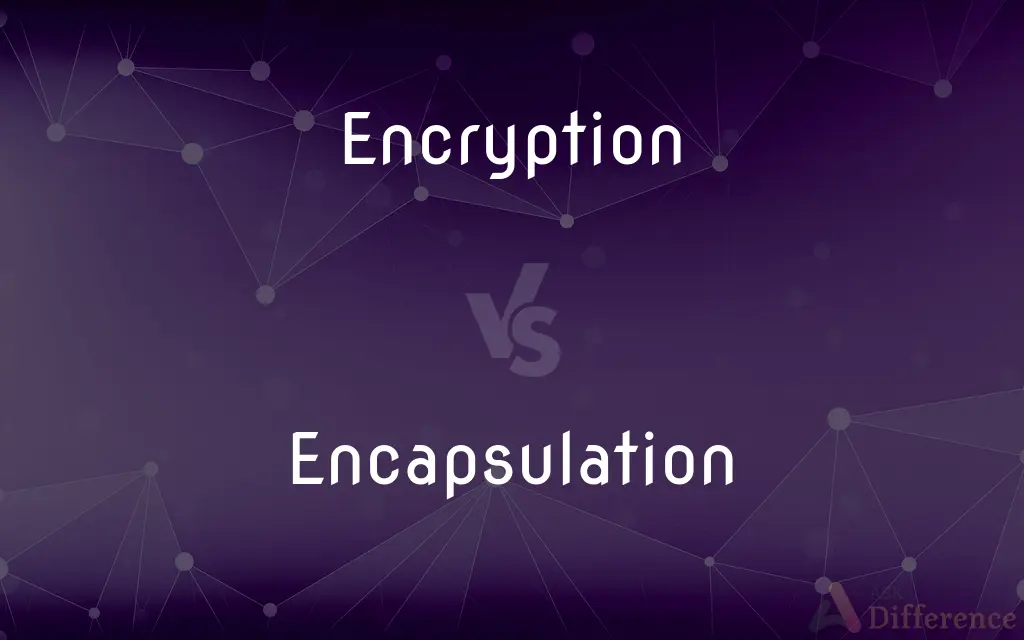Encryption vs. Encapsulation — What's the Difference?
By Maham Liaqat & Fiza Rafique — Updated on April 22, 2024
Encryption is the process of converting data into a secure format that requires a key to decode, while encapsulation is a programming concept where data and methods are bundled into a single unit.

Difference Between Encryption and Encapsulation
Table of Contents
ADVERTISEMENT
Key Differences
Encryption is primarily used in data security to convert information into a cipher or code that can only be accessed or deciphered with the correct key, ensuring that sensitive information remains confidential. On the other hand, encapsulation is a fundamental principle of object-oriented programming that involves bundling the data (variables) and the methods (functions) that manipulate the data into a single unit or class, thus hiding the details and protecting the data from outside interference.
In encryption, algorithms like AES or RSA are employed to secure data, which is crucial for maintaining privacy and integrity in communications across insecure networks such as the internet. Whereas encapsulation does not concern itself directly with security but rather with design robustness, by preventing external components from accessing and modifying the internal state of an object.
Encapsulation aids in reducing complexity and increasing reusability by keeping a clean separation between the interface and implementation of an object or module. Conversely, encryption does not necessarily reduce complexity; instead, it adds a layer of complexity that is necessary to secure data from unauthorized access.
Developers use encapsulation to create a defined interface for interaction with an object, which can be understood and utilized without needing to know the internal workings of the object. In contrast, encryption often requires careful management of keys and understanding of cryptographic protocols to ensure data remains secure both at rest and in transit.
While encapsulation is exclusive to software design and is employed across various programming languages and environments, encryption spans a broader context, including data storage, network communications, and even hardware, to protect data across various stages and forms.
ADVERTISEMENT
Comparison Chart
Definition
Securing data by transforming it into code
Bundling data and methods into a single unit
Primary Use
Data security
Software design
Key Tools/Concepts
Keys, algorithms (AES, RSA)
Classes, access modifiers (private, public)
Outcome
Data is unreadable without the correct key
Improved module integrity and reusability
Relevance in Industries
Cybersecurity, data transmission
Software engineering, application development
Compare with Definitions
Encryption
The process of converting plaintext into secure ciphertext.
Encryption of emails ensures that only the recipient can read the contents.
Encapsulation
Enhances modularity and maintenance of code.
Encapsulation allows developers to modify the backend without affecting other parts.
Encryption
Utilizes cryptographic keys for data security.
Encryption keys must be securely stored to prevent unauthorized access.
Encapsulation
Prevents external interference with inner workings.
Methods within a class manage the data, preventing external changes.
Encryption
Essential for protecting data integrity and privacy.
Encryption protects sensitive data transmitted over the internet.
Encapsulation
Combines data and functions into classes.
Encapsulation in object-oriented programming helps in organizing code.
Encryption
Can be symmetric or asymmetric, based on key usage.
Asymmetric encryption uses a public key for encryption and a private key for decryption.
Encapsulation
Fundamental in many programming paradigms.
Encapsulation is a core concept in object-oriented languages like Java and C++.
Encryption
Implemented in various protocols, including SSL/TLS.
SSL encryption secures data exchanged between browsers and websites.
Encapsulation
Uses access modifiers to protect data.
Private variables are only accessible within the same class.
Encryption
In cryptography, encryption is the process of encoding information. This process converts the original representation of the information, known as plaintext, into an alternative form known as ciphertext.
Encapsulation
To encase in or as if in a capsule.
Encryption
The process or result of encrypting data.
Encapsulation
To express in a brief summary; epitomize
Headlines that encapsulate the news.
Encryption
Cryptography.
Encapsulation
To become encapsulated.
Encryption
(cryptography) The process of obscuring information to make it unreadable without special knowledge, key files, or passwords.
Encapsulation
The act of enclosing in a capsule; the growth of a membrane around (any part) so as to enclose it in a capsule.
Encryption
(cryptography) A ciphertext, a cryptogram, an encrypted value. Usually used with the preposition "of" followed by the value that is hidden in it.
Encapsulation
Grouping together an object’s ‘state’ (its data) and the operations that may alter or interrogate it (its methods).
Encryption
The process of converting messages in ordinary language, or other information into a secret coded form that cannot be interpreted without knowing the secret method for interpretation, called the key.
Encapsulation
(networking) The process of arranging data into packets that can be transmitted using a given protocol.
Encryption
The activity of converting from plain text into code
Encapsulation
The act of inclosing in a capsule; the growth of a membrane around (any part) so as to inclose it in a capsule.
Encapsulation
The condition of being enclosed (as in a capsule);
The encapsulation of tendons in membranous sheaths
Encapsulation
The process of enclosing (as in a capsule)
Common Curiosities
Can encryption and encapsulation be used together?
Yes, they can be used together to provide both security and robust design.
What are common encryption methods?
Common methods include AES for symmetric encryption and RSA for asymmetric encryption.
How does encryption impact data performance?
Encryption can slow down system performance due to the extra processing required.
How does encapsulation benefit software development?
It enhances code modularity, maintainability, and reusability.
What is the main purpose of encryption?
To secure data by making it unreadable without a specific key.
How do access modifiers relate to encapsulation?
Access modifiers like private, public, and protected control what parts of the program can access the data in a class.
What is an example of encapsulation in everyday software?
A user interface that hides the complex code behind simple interactive elements.
Are there any specific tools needed for encryption?
Encryption tools include cryptographic libraries and key management systems.
Which industries rely heavily on encryption?
Industries such as banking, healthcare, and e-commerce heavily rely on encryption for data security.
What happens if encapsulation principles are not followed?
The software may become hard to manage, with increased risk of bugs and security issues.
Share Your Discovery

Previous Comparison
Implication vs. Effect
Next Comparison
Affectionate vs. PassionateAuthor Spotlight
Written by
Maham LiaqatCo-written by
Fiza RafiqueFiza Rafique is a skilled content writer at AskDifference.com, where she meticulously refines and enhances written pieces. Drawing from her vast editorial expertise, Fiza ensures clarity, accuracy, and precision in every article. Passionate about language, she continually seeks to elevate the quality of content for readers worldwide.














































